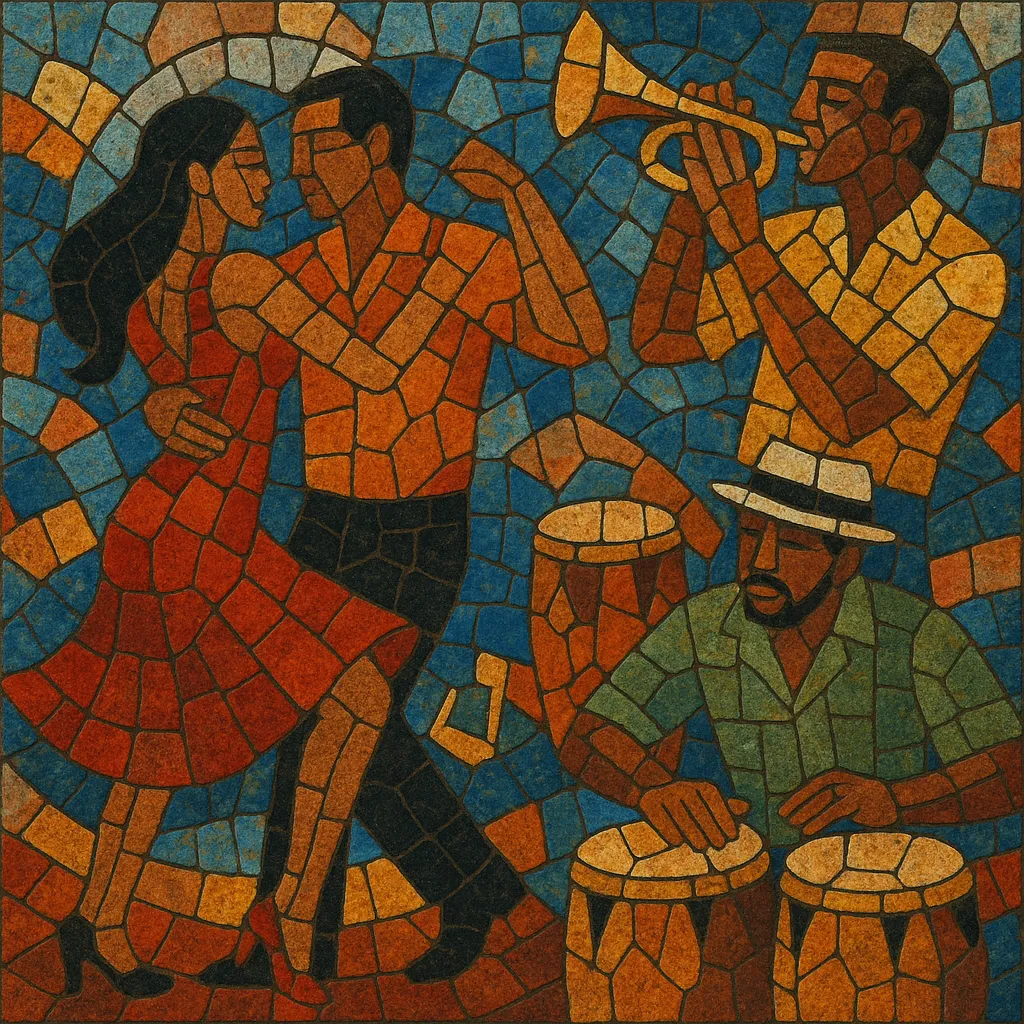Salsa is a pan–Latin dance music forged primarily in New York City by Puerto Rican, Cuban, and other Caribbean diasporas. It synthesizes Afro‑Cuban rhythmic blueprints, Puerto Rican bomba and plena, jazz harmony, big‑band horn writing, and Nuyorican street culture into a tightly arranged yet improvisation‑friendly style.
The music lives on the clave (either 2‑3 or 3‑2), with layered percussion (congas, bongó, timbales, cowbell, güiro, maracas), a tumbao bass that anticipates the beat, and piano montuno guajeos that interlock with the rhythm section. Call‑and‑response vocals (coro/pregón), punchy horn mambos and moñas, and instrumental solos energize the montuno section. Tempos range from medium to fast in 4/4, optimized for social dancing (commonly “on1” or “on2”).
Across decades, salsa has branched into harder, percussion‑forward “salsa dura,” smoother “salsa romántica,” and regional scenes in Puerto Rico, Venezuela, and Colombia, while continuing to influence—and be influenced by—neighboring tropical and jazz idioms.
Salsa’s roots lie in mid‑20th‑century Cuban and Puerto Rican dance music circulating through New York City ballrooms and barrios. Mambo, cha‑cha‑chá, son cubano/son montuno, charanga (flute/violins), and descarga jam sessions mixed with Puerto Rican bomba and plena and the harmonic sensibilities of jazz. In the mid‑1960s, Latin boogaloo brought bilingual street swagger and R&B grooves to the scene, foreshadowing a new, urban Afro‑Caribbean synthesis.
By the early 1970s, labels like Fania Records consolidated this ecosystem under the marketable banner “salsa.” The Fania All‑Stars, Willie Colón, Héctor Lavoe, Eddie Palmieri, Celia Cruz, Ray Barretto, Johnny Pacheco, and Tito Puente defined the sound: clave‑centric rhythm sections, montuno vamps, brassy mambos, coro/pregón exchanges, and virtuosic solos. Salsa spread rapidly to Puerto Rico, Venezuela, and Colombia, becoming both a dance craze and an assertive Nuyorican cultural voice.
The 1980s saw two parallel currents: a smoother, romantic radio format (“salsa romántica”) and a gritty, percussion‑heavy approach (“salsa dura”). Colombian bands (e.g., El Gran Combo’s regional popularity, later Grupo Niche and others) and Venezuelan orquestas amplified local flavors, while arrangers expanded harmonic palettes and horn voicings. International touring and ballroom pedagogy helped standardize social styles (on1/on2), cementing salsa’s global dance identity.
Salsa remains a worldwide live and social‑dance staple, from New York to Cali to Tokyo. Cross‑pollination with Cuban timba, pop, and urban Latin styles continues, while scenes like Cali’s fast, athletic school and Colombia’s salsa choke show new rhythmic fusions. Conservatory‑level musicianship, sophisticated arranging, and community dance circuits keep the genre vibrant in clubs, festivals, and classrooms.
Start in 4/4 with the clave as the structural spine (choose 2‑3 or 3‑2 and commit). Build a layered percussion section: congas (tumbao), bongó (with martillo and campana in montuno), timbales (cáscara, fills, and bell), cowbell, güiro, and maracas. Keep the bass tumbao anticipatory (often tying into the “and of 2” or “and of 4”) and lock it to the conga slap accents.
Write a cyclic piano montuno (guajeo) using chord tones and syncopated diads/octaves that dovetail with the clave direction. Bass should be sparse but propulsive, avoiding downbeats that clash with clave accents. Guitar or tres can double/answer the montuno for additional texture.
Use diatonic harmony with jazz extensions (9ths, 11ths, 13ths) and common progressions like ii–V–I, iv–V, or modal vamps. Arrange horns (trumpets and/or trombones, sometimes sax) for tight mambos and moñas—short, syncopated riffs that answer the coro or kick off solos. Charanga colors (flute/violins) can soften the texture for old‑school flavors.
Typical flow: intro → verso (narrative) → coro/pregón (call‑and‑response) → montuno (vamps, horn mambos, solos) → breakdowns → coda. Ensure every hit respects the clave. Use stop‑time figures, percussion breaks, and coro hooks to escalate energy.
Lead vocals (sonero) should improvise soneos during the montuno, responding to the coro. Lyrical themes range from street life and social commentary to romance and celebration; keep phrasing rhythmically crisp to ride the groove.
Record percussion with minimal bleed and consistent mic placement to preserve transients. Pan percussion for a natural stage image (e.g., conga center‑left, bongó/timbales center‑right). Maintain dynamic headroom so horn mambos and breaks hit hard without harshness. Above all, check every line against clave alignment.


